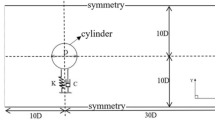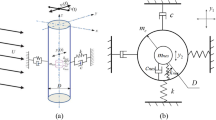Abstract
In the study of the cross-flow vortex-induced vibration of the cylinder, it is found that with the increase in the Reynolds number, the upper branch of the vibration amplitude and the lock-in region show an increasing trend. Currently, there are relatively few studies on two-degree-of-freedom VIV at high Reynolds number. In this paper, the Launder and Sharma low Reynolds number k–ɛ turbulence model is modified by limiting the kinetic energy generation term and dissipation term, which is similar with the limiter used in SST k–ω model. Based on the modified turbulence model, the two-degree-of-freedom vortex-induced vibration of the cylinder with different Reynolds numbers is simulated with the two-dimensional RANS method. The accuracy of the improved turbulence model and its applicable Reynolds number range are verified by comparing with experiments and relevant numerical simulations. The effects of Reynolds number on the vibration characteristics of cylinder with low mass damping ratio are discussed, which provide a theoretical reference for the study of vortex-induced vibration under high Reynolds number.






















Similar content being viewed by others
References
Lucor D, Foo J, Karniadakis GE (2005) Vortex mode selection of a rigid cylinder subject to VIV at low mass-damping. J Fluids Struct 20(4):483–503. https://doi.org/10.1016/j.jfluidstructs.2005.02.002
Dong S, Karniadakis GE (2005) DNS of flow past a stationary and oscillating cylinder at Re = 10000. J Fluids Struct 20(4):519–531. https://doi.org/10.1016/j.jfluidstructs.2005.02.004
Al-Jamal H, Dalton C (2004) Vortex induced vibrations using Large Eddy simulation at a moderate Reynolds number. J Fluids Struct 19(1):73–92. https://doi.org/10.1016/j.jfluidstructs.2003.10.005
Pontaza JP, Chen HC (2006) Three-dimensional numerical simulations of circular cylinders undergoing two degree-of-freedom vortex-induced vibrations. Int Conf Offshore Mech Arct Eng 92052:497–504. https://doi.org/10.1115/OMAE2006-92052
Wanderley J, Souza G, Sphaier S et al (2008) Vortex-induced vibration of an elastically mounted circular cylinder using an upwind TVD two-dimensional numerical scheme. Ocean Eng 35:1533–1544. https://doi.org/10.1016/j.oceaneng.2008.06.007
Chien KY (1982) Predictions of channel and boundary layer flows with a low-reynolds-number two-equation model of turbulence. AIAA J 20(1):33–38. https://doi.org/10.2514/3.51043
Kinaci OK (2016) 2-D urans simulations of vortex induced vibrations of circular cylinder at trsl3 flow regime. J Appl Fluid Mech 9(5):2537–2544. https://doi.org/10.18869/acadpub.jafm.68.236.25136
Kang Z, Ni W, Sun L (2017) A numerical investigation on capturing the maximum transverse amplitude in vortex induced vibration for low mass ratio. Mar Struct 52:94–107. https://doi.org/10.1016/j.marstruc.2016.11.006
Raghavan K, Bernitsas MM (2011) Experimental investigation of Reynolds number effect on vortex induced vibration of rigid circular cylinder on elastic supports. Ocean Eng 38(5–6):719–731. https://doi.org/10.1016/j.oceaneng.2010.09.003
Narendran K, Murali K, Sundar V (2015) Vortex-induced vibrations of elastically mounted circular cylinder at Re of the O (105). J Fluids Struct 54:503–521. https://doi.org/10.1016/j.jfluidstructs.2014.12.006
Ding ZJ, Balasubramanian S, Lokken RT et al (2004) Lift and damping characteristics of bare and straked cylinders at Riser Scale Reynolds numbers. Offshore Technol Conf 16341:1–9. https://doi.org/10.4043/16341-MS
Modir A, Kahrom M, Farshidianfar A (2016) Mass ratio effect on vortex induced vibration of a flexibly mounted circular cylinder, an experimental study. Int J Mar Energy 16:1–11. https://doi.org/10.1016/j.ijome.2016.05.001
Kang Z, Zhang C, Chang R et al (2019) A numerical investigation of the effects of Reynolds number on vortex-induced vibration of the cylinders with different mass ratios and frequency ratios. Int J Nav Archit Ocean Eng 11:835–850. https://doi.org/10.1016/j.ijnaoe.2019.02.012
Launder BE, Sharma BI (1974) Application of the energy-dissipation model of turbulence to the calculation of flow near a spinning disc. Lett Heat Mass Transf 1(2):131–137. https://doi.org/10.1016/0094-4548(74)90150-7
Menter F R (1993) Zonal two equation k-w turbulence models for aerodynamic flows. AIAA 23rd Fluid Dynamics, Plasmadynamics, and Lasers Conference 2906.https://doi.org/10.2514/6.1993-2906
Menter FR (2003) Ten years of industrial experience with the SST turbulence mode. Turbul Heat Mass Transf 4:625–632
Johnson DA, King LS et al (1985) A mathematically simple turbulence closure model for attached and separated turbulent boundary layers. AIAA J 23(11):1684–1692. https://doi.org/10.2514/3.9152
Zhang Y, Xu JL, Bai JQ et al (2014) A transition prediction method based on turbulence kinetic equation. Chin J Theor Appl Mech 46(1):160–164
Liang C, Papadakis G, Luo X (2008) Large eddy simulation of cross-flow through a staggered tube bundle at subcritical Reynolds number. Comput Fluids 38:950–964. https://doi.org/10.1016/j.jfluidstructs.2007.05.004
Jauvtis N, Williamson CHK (2004) The effect of two degrees of freedom on vortex-induced vibration at low mass and damping. J Fluid Mech 509:23–62. https://doi.org/10.1017/S0022112004008778
Norberg C (1994) Experimental investigation of the flow around a circular cylinder: influence of aspect ratio. J Fluid Mech 258(258):287–316. https://doi.org/10.1017/S0022112094003332
Norberg C (1993) Pressure forces on a circular cylinder in cross flow. Bluff-body wakes. Dynamics and Instabilities. Springer, Berlin, pp 275–278. https://doi.org/10.1007/978-3-662-00414-2_60
Achenbach E (1968) Distribution of local pressure and skin friction around a circular cylinder in cross-flow up to Re = 5*10^6. J Fluid Mech 34(4):625–639. https://doi.org/10.1017/S0022112068002120
Cantwell B, Coles D (1983) An experimental study of entrainment and transport in the turbulent near wake of a circular cylinder. J Fluid Mech. 136:321–374. https://doi.org/10.1017/S0022112083002189
Srinil N, Zanganeh H, Day A (2013) Two-degree-of-freedom VIV of circular cylinder with variable natural frequency ratio: experimental and numerical investigations. Ocean Eng 73(8):179–194. https://doi.org/10.1016/j.oceaneng.2013.07.024
Lusheng J (2012) Investigation on Self-excited vibration of 2-Dof cylinder under multi boundary conditions. Harbin Engineering University, Harbin
Xu JL, Zhu RQ (2009) Numerical simulation of VIV for an elastic cylinder mounted on the spring supports with low mass-ratio. J Mar Sci Appl 8(3):237–245
Acknowledgements
The work presented here is supported by the National Natural Science Foundation of China with Grant number 51879047.
Author information
Authors and Affiliations
Corresponding author
Additional information
Publisher's Note
Springer Nature remains neutral with regard to jurisdictional claims in published maps and institutional affiliations.
About this article
Cite this article
Kang, Z., Yang, C., Zhang, C. et al. Modification and application of low Reynolds number k–ɛ turbulence model to vortex-induced vibration at subcritical Reynolds number range. J Mar Sci Technol 26, 713–733 (2021). https://doi.org/10.1007/s00773-020-00749-y
Received:
Accepted:
Published:
Issue Date:
DOI: https://doi.org/10.1007/s00773-020-00749-y




